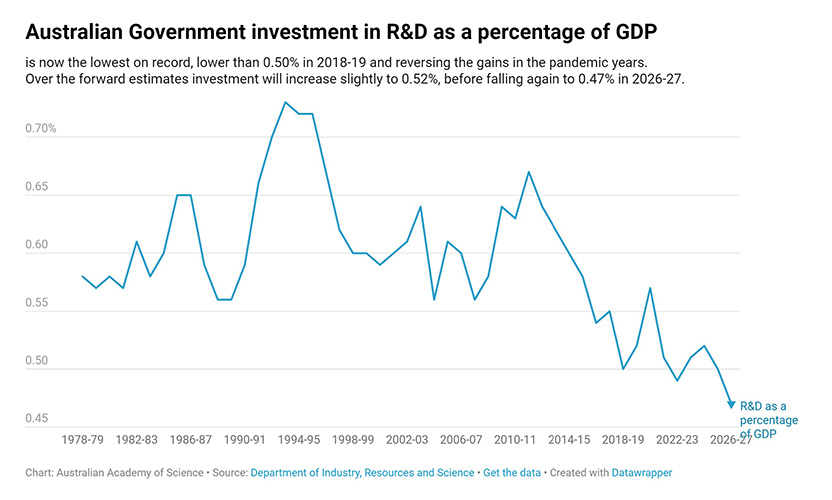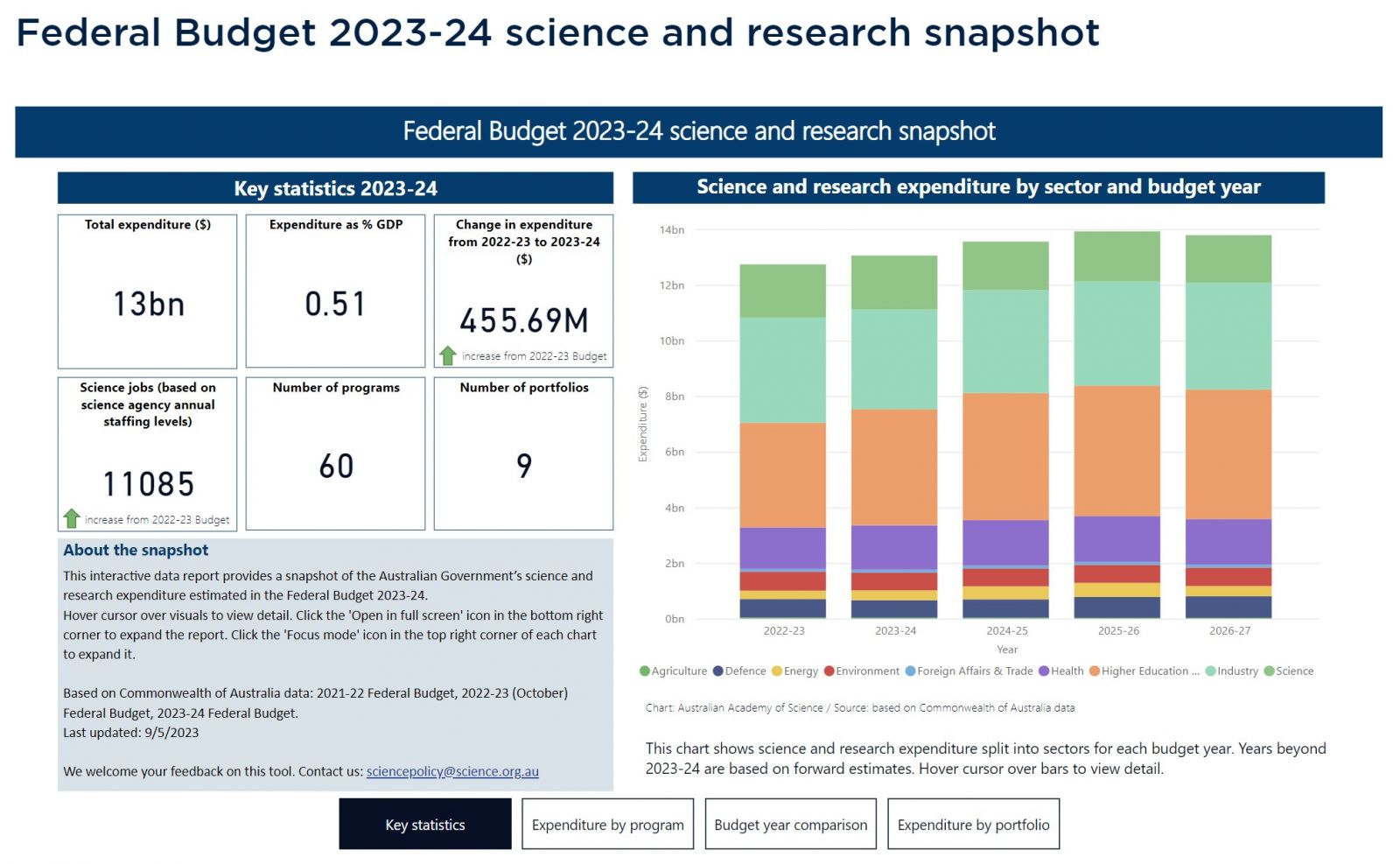
The Science Policy and Diplomacy Newsletter of the Australian Academy of Science highlights important science policy discussions and events in Australia and around the globe. We report on the involvement of science in national and international policy and diplomacy, and the Academy’s contributions to these discussions.
This special edition offers a recap and analysis of the Federal Budget 2023–24 and highlights the opportunities and issues for science and research.
.png)
The Australian Academy of Science welcomes the Albanese Government’s ongoing support for science and research in the 2023–24 Federal Budget.
The budget contained no major cuts to science and contained much-needed investment in several scientific institutions and agencies. With multiple reviews underway, which are yet to reach their conclusion, this budget was always going to be ‘business as usual’.
The Academy’s prebudget submission recommendations were unrealised, including a plan for increasing R&D investment, and a root and branch review of the science system.

Overall, there was not a major shift in investment in research funding in the 2023–24 Federal Budget. Both expenditure and staffing levels saw unremarkable increases, with approximate research and development expenditure sitting at 0.51% of GDP, compared to 0.49% of GDP in 2022–23, according to the recently released Science and Research Innovation tables.
Over the forward estimates, research and development expenditure is estimated to fall to 0.47% in 2026–27.

Federal Budget Science and Research Snapshot: The snapshot is a new initiative by the Academy to help communicate the impact of the budget on science and research programs. As a new initiative, we welcome ideas on how it could be improved, made more robust and relevant to your interests.
The budget contained no major changes to university research and the two main funding councils—the Australian Research Council (ARC) and the National Health and Medical Research Council (NHMRC). Reflecting the inflation environment, all the programs received CPI-based indexation next year, retaining their value.
This budget also sees the maturation of several schemes to help promote university research commercialisation, including the ARC Industry Fellowships, the Trailblazer Universities program, Australia’s Economic Accelerator and the newly announced Industry Growth Program. Budget Paper 1 reveals that research translation schemes will be worth A$364 million in 2023–24.
Science agencies, including the Australian Institute of Marine Science (AIMS), Australian Nuclear Science and Technology Organisation (ANSTO), Questacon and the National Measurement Institute, have received increased budget appropriations. Funding for AIMS will go into the workforce, infrastructure, monitoring and a new research vessel.
Funding for the Commonwealth Scientific and Industrial Research Organisation (CSIRO) remains constant, but the government appropriation will fall from 2024–25 as a COVID pandemic funding measure expires. Future budgets assume that overall CSIRO resourcing will remain constant, but that depends on the CSIRO growing other revenue sources.
Similarly, Geoscience Australia will see funding decline as programs are completed in future years.
Overall, jobs across the agencies are increasing—an increase of average staffing levels by almost 700 over the previous year. The highest increases are at the CSIRO (250), the Bureau of Meteorology (127), ANSTO (114) and AIMS (47).
There has been a continuation of support for the National Science and Technology Council to work with organisations such as the Academy to provide science advice to government. This support extends to include the Prime Ministers Prize for Science and Science Meets Parliament.
The government will also provide A$7.9 million over four years from 2023–24 for the Australian Communications and Media Authority to combat online misinformation and disinformation on global digital platforms to reduce the spread of harmful content. Read the Australian Academy of Technology and Engineering and the Academy of Science’s joint submission to the Digital Industry Group Inc’s first annual review of the Australian Code of Practice on Disinformation and Misinformation here.
There has been a cut of around A$25 million over the forward estimates to the Global Science and Diplomacy Fund. Whether this will impact the strategic or bilateral stream of the funding remains unclear.
Funding for AI has been bundled into A$116 million over five years that will support the development and adoption of critical technologies, including quantum. This includes the previously announced National AI Centre and its role in supporting responsible AI usage.
There are varied investments in nuclear science capability beyond the significant investments to support the nuclear-powered submarine capability, including much-needed infrastructure for ANSTO. The government will provide a decade of funding to ANSTO, including funding for ANSTO to develop a business case for a new facility to support Australia’s sovereign nuclear security science capability.
A number of initiatives have been announced in the budget around the government’s Nature Positive Plan, including funding for a new Environment Protection Agency, Environment Information Australia, and funding to fix Australia’s broken environmental laws.
Other initiatives include: funding for a review of the Murray-Darling Basin Plan, including updated science; Australia’s first National Climate Risk Assessment; and funding for a National Climate Adaptation Plan.
The National Environmental Science Program funding remains in place. Disappointingly, funding for the Australian Biological Resources Study, which turns 50 this year and supports Australian species discovery, remains at A$2.03 million a year—an amount that has not changed since the 1990s.
The major science-focussed initiative is the establishment of the Advanced Strategic Capability Accelerator within the Department of Defence with funding of A$3.45 billion over 10 years. Much of this funding over the forward estimates comes from repurposing the Defence Innovation Hub and Next Generation Technologies Fund.
There will be 4,000 additional commencing Commonwealth-supported places at universities for courses that support the skills requirements of the nuclear-powered submarine program, as well as funding for ANSTO, the Australian Radiation Protection and Nuclear Safety Agency (ARPANSA) and the Australian Radioactive Waste Agency to manage Australia’s nuclear non-proliferation obligations.
Changes have been made to funding for space industry funds and resources for the Australian Space Agency in the budget.
An additional A$34.2 million over three years from 2023–24 has been allocated to the Australian Space Agency. In terms of programs, it seems that:
The cuts appear to balance out the additional funding to the space agency, but there may be more in the detail.
The Academy’s budget media release.
The Academy’s prebudget submission.
© 2025 Australian Academy of Science